Palace of the Grand Master of the Knights of Rhodes
| Palace of the Grand Master | |
|---|---|
| Παλάτι του Μεγάλου Μαγίστρου | |
| Part of the fortifications of Rhodes | |
| Rhodes, Greece | |
 View of the castle | |
| Coordinates | 36°26′44.5″N 28°13′26.8″E / 36.445694°N 28.224111°E |
| Type | Castle |
| Site information | |
| Owner | Government of Greece[1] |
| Open to the public | Yes |
| Condition | Intact |
| Site history | |
| Built |
7th century (citadel) 14th century (palace) 1937–1940 (restoration works) |
| Built by |
Byzantine Empire Knights Hospitaller Kingdom of Italy (restoration works) |
| Battles/wars |
Siege of Rhodes (1480) Siege of Rhodes (1522) |
| Events | |
| Type | Cultural |
| Criteria | ii, iv, v |
| Designated | 1988 (12th session) |
| Part of | Medieval old town of Rhodes |
| Reference no. | 493 |
| State Party |
|
| Region | Europe and North America |
The Palace of the Grand Master of the Knights of Rhodes, also known as the Kastello (Greek: Καστέλο, from Italian: Castello, "castle"), is a medieval castle in the city of Rhodes, on the island of Rhodes in Greece. It is one of the few examples of Gothic architecture in Greece. The site was previously a citadel of the Knights Hospitaller that functioned as a palace, headquarters, and fortress.
History
According to recent study, in the exact spot in which the palace exists today, there was the foundations of the ancient temple of the Sun-god 'Helios' and probably that was the spot where Colossus of Rhodes stood in the Antiquity. The palace was originally built in the late 7th century as a Byzantine citadel. After the Knights Hospitaller occupied Rhodes and some other Greek islands (such as Kalymnos and Kastellorizo) in 1309, they converted the fortress into their administrative centre and the palace of their Grand Master. In the first quarter of the 14th century, they repaired the palace and made a number of major modifications.[2] The palace was damaged in the earthquake of 1481, and it was repaired soon afterwards.
After the 1522 capture of the island by the Ottoman Empire, the palace was used as a command centre and fortress. The lower part of the palace was severely damaged by an ammunition explosion in 1856.[3] As a result, many rooms in the first floor were destroyed.[2]
During the Italian rule of Rhodes, the Italian architect Vittorio Mesturino restored the damaged parts of the palace between 1937 and 1940.[4] It became a holiday residence for the King of Italy, Victor Emmanuel III, and later for Fascist dictator Benito Mussolini, whose name can still be seen on a large plaque near the entrance.
On 10 February 1947, the Treaty of Peace with Italy, one of the Paris Peace Treaties, determined that the recently established Italian Republic would transfer the Dodecanese Islands to Greece. In 1948, Rhodes and the rest of the Dodecanese were transferred as previously agreed. The palace was then converted to a museum, and is today visited by the millions of tourists that visit Rhodes.[5]
In 1988, when Greece held the rotating presidency of the European Economic Community (as the European Union was then known), Greek Prime Minister Andreas Papandreou and the other leaders of the EEC held a meeting in the Palace.[5]
Gallery
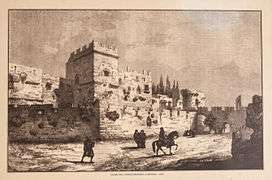 The palace in 1844
The palace in 1844 The castle overlooking the medieval town
The castle overlooking the medieval town- The main entrance
- Chimneys
 Detail
Detail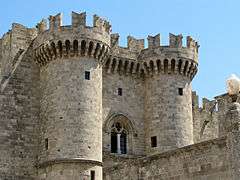 Close view
Close view Door
Door- Courtyard
- Arcades at the courtyard
 Sculpture of Virgin Mary
Sculpture of Virgin Mary- View from the interior
- Gothic portal
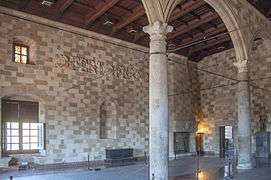 Main hall
Main hall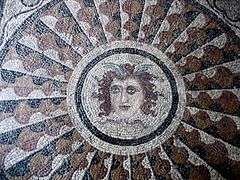 Medusa mosaic (2nd century BC) from Kos
Medusa mosaic (2nd century BC) from Kos- Mosaic with Thalia (Muse) from Kos
- Mosaic with Polyhymnia from Kos
- Byzantine mosaic from Kos (450-500)
- Byzantine mosaic from Kos
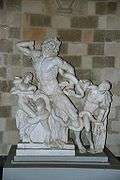 Laocoön and His Sons, modern copy
Laocoön and His Sons, modern copy- Portrait of Philibert de Naillac, Grand Master (1396-1421)
- Uniform of the Sovereign Military Order of Malta
See also
References
| Wikimedia Commons has media related to Palace of the Grand Master of the Knights of Rhodes. |
| Wikimedia Commons has media related to Mosaics in the Palace of the Grand Master of the Knights of Rhodes. |
- ↑ "Grand Master Palace". greeka.com. Retrieved 17 July 2015.
- 1 2 "Palace of the Grand Master of Rhodes". Helios. Retrieved 17 July 2015.
- ↑ "Rhodes Town Tourist Attractions". planetware.com. Retrieved 17 July 2015.
- ↑ "Palace of the Grand Master of the Knights of Rhodes". Fodor's Travel. Retrieved 17 July 2015.
- 1 2 "Museums". Municipality of Rhodes. Archived from the original on 21 July 2015. Retrieved 17 July 2015.
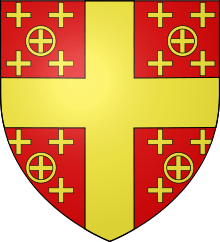

.svg.png)